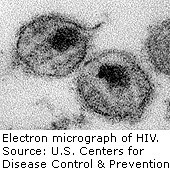
WEDNESDAY, March 5, 2014 (HealthDay News) — In an early step toward drug-free HIV therapy, researchers are reporting the first success in genetically “editing” T-cells in patients’ immune systems to become resistant to the virus.
The findings, published in the March 6 issue of the New England Journal of Medicine, are based on only 12 patients. But experts were cautiously optimistic about what the study accomplished.
Specifically, researchers were able to take T-cells from the HIV patients’ blood, then “knock out” a gene known as CCR5, which controls a protein that allows HIV to enter a cell.
The scientists then infused the genetically altered T-cells back into patients’ blood, where they expanded in number. What’s more, a few patients were taken off their HIV drugs temporarily and saw their virus levels decrease.
“This is impressive,” said Rowena Johnston, director of research for amfAR, the Foundation for AIDS Research.
The altered T-cells “actually seem to be doing exactly what [the researchers] wanted them to,” said Johnston, who was not involved in the study.
Still, she said, there are plenty of questions left and much research ahead. The investigators on the study agreed.
“This was a first-in-human study,” said researcher Bruce Levine, an associate professor of cancer gene therapy at the University of Pennsylvania School of Medicine, in Philadelphia.
That means the trial was designed to see whether it’s even safe to use this approach in people with HIV — and not whether it’s an effective therapy.
The T-cell infusions did appear safe in the short term: Of the 12 patients, only one had a temporary reaction — developing fever, chills and joint pain within 24 hours of the infusion.
“Right now, we’re at the point where we’ve demonstrated safety and feasibility,” Levine said.
Ultimately, scientists want to develop a “functional” cure for HIV — where people’s immune system cells are resistant to the virus, and they can stop taking the lifelong, daily drug regimens currently used to suppress the infection.
Those drugs have turned HIV into a manageable chronic disease for many. But, Levine said, they are costly, cause side effects, and for some people, eventually lose their effectiveness.
No one knows whether the technology used in this study will eventually offer a functional cure. But Levine said there were “hints” that, with further refinement, it could.
One month after the T-cell infusion, half of the study patients stopped their regular HIV drug regimen for up to 12 weeks. Initially, the patients’ “viral load” increased, but for the four who were able to stay off their medication for the full 12 weeks, the viral load declined toward the end.
There were also signs that some of the modified T-cells were resistant to HIV: When patients stopped their medications, the infused T-cells did decline in number — but not to the extent that their unmodified T-cells did.
HIV researchers have been studying the CCR5 protein for years. It’s long been known, Levine said, that the protein allows HIV to gain entry into cells. And people who have a particular mutation in both copies of their CCR5 gene (inherited from both parents) are protected from HIV infection.
CCR5 research has gained momentum in the past several years — particularly after the famous case of the “Berlin patient,” who is considered the first person to be cured of HIV.
That patient, whose real name is Timothy Ray Brown, was HIV-positive back in 2007, when he underwent a bone marrow transplant to treat leukemia. His bone marrow donor carried two copies of the CCR5 mutation, and the transplant not only cured his cancer, but also knocked his HIV levels below the threshold of detection. He has been off of HIV drugs since 2008.
For the current study, Levine and his colleagues tried to mimic that CCR5 mutation using what’s called a zinc-finger nuclease — which is basically an artificial enzyme that can snip DNA at a specific site.
That effectively knocked out the CCR5 gene in 11 percent to 28 percent of patients’ T-cells before they were re-infused.
Levine said one of the more immediate goals now is to make the process more efficient. Right now, the technology knocks out both copies of CCR5 in some cells, but only one copy in others.
“Ideally, you’d like both copies knocked out,” Levine said.
Of the four patients in this study whose viral levels declined after stopping their medication, one had undetectable HIV levels when the drug treatment was restarted. Levine’s team later found that the patient naturally carried one copy of the CCR5 mutation.
So that patient, Levine said, essentially got a “head start,” because there was no need for both CCR5 copies to be knocked out.
For her part, Johnston agreed that boosting the efficiency of the CCR5 knockout technique will be key. She said it also has to be tested in larger and more diverse groups of people with HIV, and researchers need to understand how the immune system responds over the long term.
And the “holy grail,” Johnston said, would be to apply gene therapy to the bone marrow stem cells that give rise to the immune system, and not only T-cells.
Worldwide, more than 33 million people are living with HIV/AIDS, and 97 percent of them are in low- to middle-income countries, according to the U.S. Department of Health and Human Services.
If this or any other gene therapy were found to control HIV without the use of drugs, there would still be the questions of how to get it to people, and how to pay for it.
According to the World Health Organization, most people living with the disease globally do not have access to the current treatments.
But Johnston said she believes that if scientists can develop an effective gene therapy, others would find a way to get it to people living with HIV.
“I’m optimistic,” she said. “For many years, people didn’t think it would ever be possible to cure HIV. Now the question is no longer, ‘Is it possible?’ It’s ‘How are we going to do it?'”
The study was partly funded by Richmond, Calif.-based Sangamo BioSciences, which is developing the zinc-finger nuclease technology used in the research. Several co-researchers on the work are employees of the company.
More information
The U.S. Department of Health and Human Services has more on HIV/AIDS.
Copyright © 2025 HealthDay. All rights reserved.

